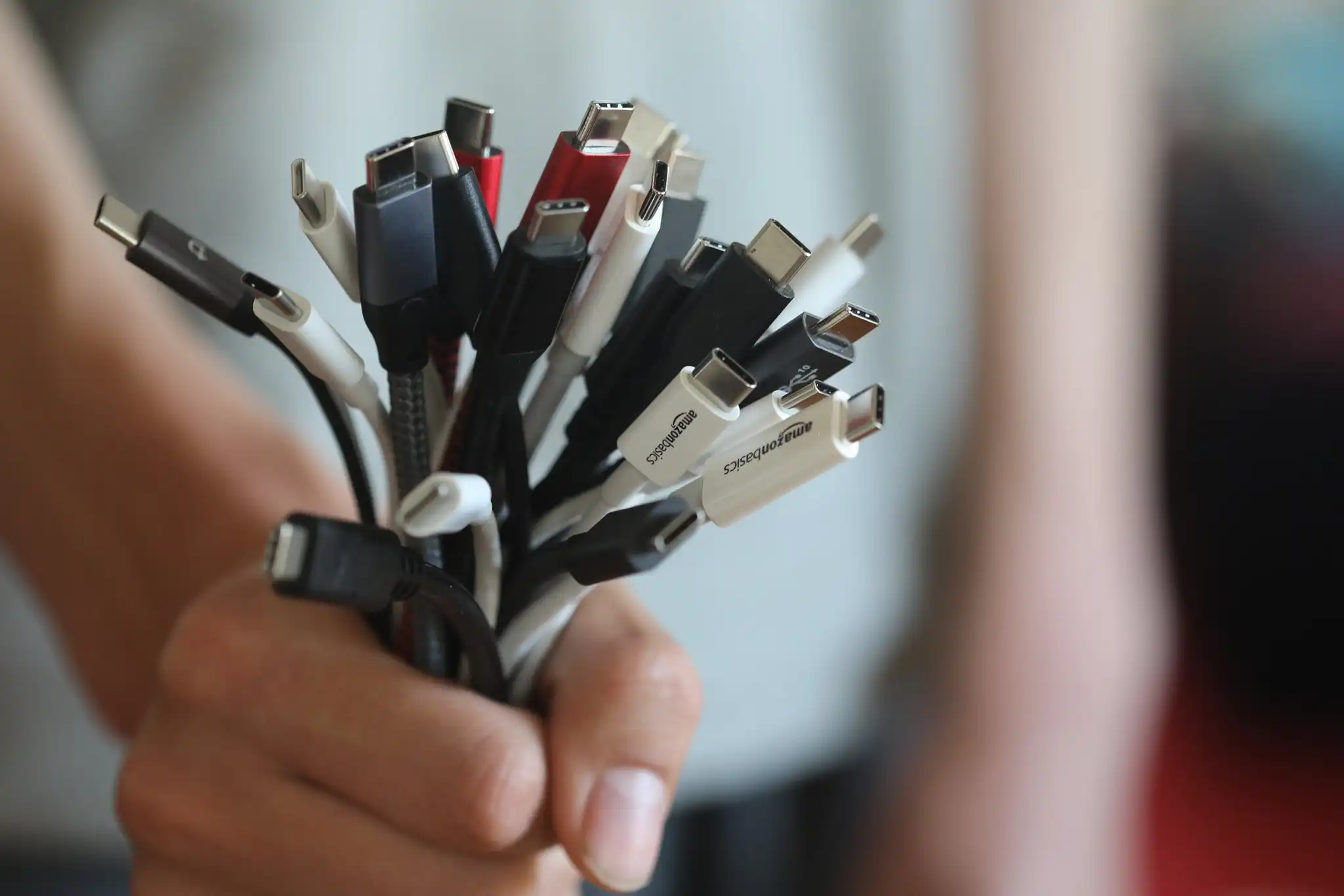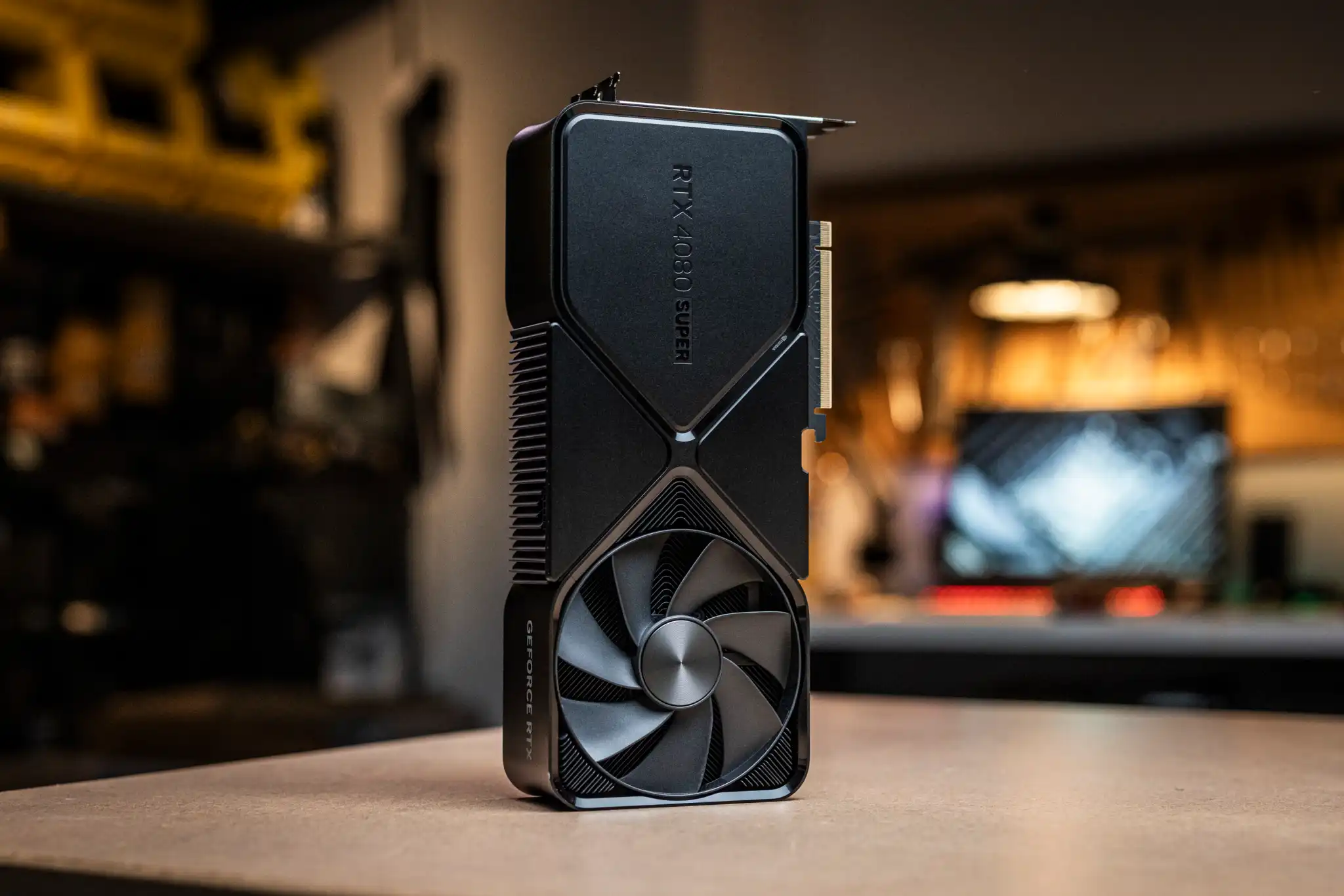We bought a bunch of USB-C cables and put them through the wringer.
It’s easy to think that all USB-C cables are the same, and that manufacturers are only claiming to be superior in order to jack up the price. After all, it’s just a cable, right?
That’s completely understandable, but not always accurate. We at PCWorld have tested a ton of USB-C cables and we can say with certainty not all of them are made the same. In fact, we noticed huge performance differences among cables when it comes to both charging and transferring data.
Our hands-on evaluation of numerous cables ranging from the biggest, most-recognizable brand-names to the cheapest of the cheap has revealed some clear winners, which we highlight below.
Our picks are separated into two groups to avoid any confusion: USB-C cables that are best for charging, and those best for both charging and fast data transfer.
For more information you can refer to our guide on how to buy a USB-C cable on Amazon without losing your mind, and you can find out more about how we test cables below our picks.
Best USB-C cable for charging
Belkin BoostCharge 240-watt charging cable

Ever since Apple stopped selling our top big-brand cable for charging, we’ve been looking for a suitable replacement and we may have finally found it with Belkin’s BoostCharge 240-watt charging cable.
This 6.6-foot, or 2-meter, cable supports the highest USB-Power Delivery charge rate, comes from a recognized big-brand, and is the same price as Apple’s 100-watt cable that used to sell for $19.99 all day.
What happened to Apple’s 100-watt charging cable? In keeping with updated USB power delivery specs, which moves the bar from 100 watts to 240 watts for faster charge rates, Apple dumped the 100-watt 6.6-foot cable for a new 240-watt cable and *cough* increased the price from $19.99 to $29.99.
The good news is the Belkin BoostCharge 240-watt charging cable is a worthy alternative to Apple’s offering.
Internally, the cable is just about on par with the Apple cable for cable resistance. That’s a good thing because Apple’s cables are actually internally constructed quite well in our experience. It’s the outside of Apple cables that has a reputation for falling apart and fraying.
The BoostCharge gives us more confidence than Apple with its pleasant braiding, beefy overmolding and Belkin’s boast that the cable has been tested to more than 30,000 bends.
The BoostCharge also features dual eMarker chips, which support over-temperature protection. With 240-watt charge rates, that last feature is particularly important as the BoostCharge can detect if it’s overheating and signal the devices to pause until it has cooled down enough.
The biggest bummer is the lack of wiring to support video output or actual high-speed data transfers. The BoostCharge is basically a plain-Jane charging cable supporting 480MBps transfer rates (vs. 10Gbps or 20Gbps).
That’s fine though, because most people are simply charging a laptop, tablet, or phone, and don’t need all of those features nor the bulk (data cables tend to be much thicker due to the extra wiring). We actually recommend that most people buy a basic charging cable for the daily abuse of plugging and unplugging devices, and, if necessary, reserving a shorter and higher-capability cable strictly for transferring chores. This should make the pricier fast data and video cable last far longer.
Sure, the Belkin is $20 and perhaps not the best value, but for someone looking for the warm embrace of a big brand to make them feel better, we think the BoostCharge cable is a good pick. The TLDR is if you would have bought an Apple cable but you’re balking at $29 for the equivalent — pick up the Belkin BoostCharge instead. If the Apple brand makes you feel more comfortable, read on.
Anker New Nylon Series 3 USB-C to USB-C 2-pack
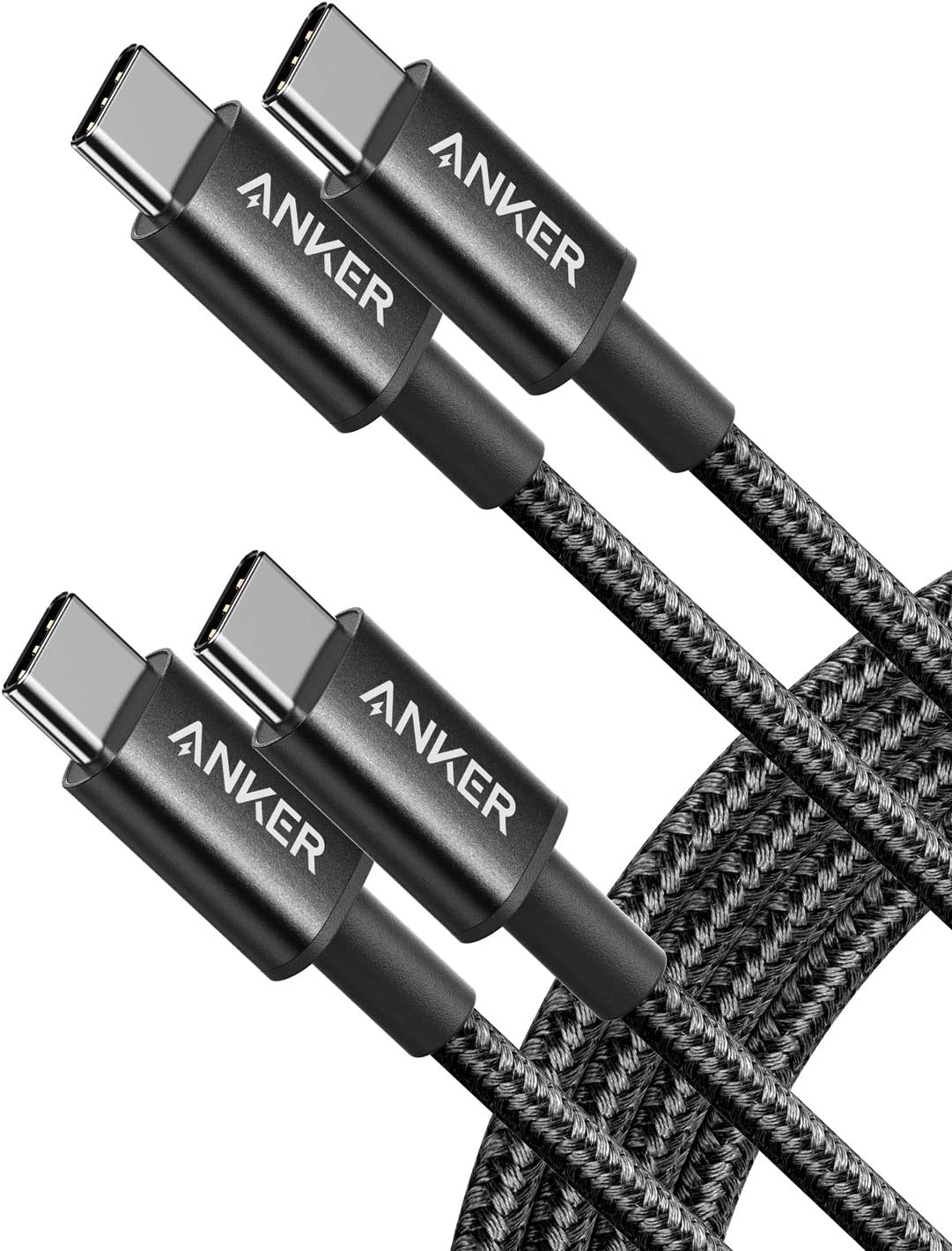
At the time of our review, the Anker New Nylon 2-pack was the No. 1 best-selling USB-C cable on Amazon and that’s probably for good reason. At roughly $14 for a pair of 6-foot USB-C to USB-C charging cables from a brand-name people trust, it’s a great value, and for most people looking to handle phone-, small laptop-, and tablet-charging duties-, you probably don’t need to read any further. Just click add to the cart, and move on. If, however, you are someone looking for the caveats with this Anker pair of cables, read on.
The New Nylon 2-pack cables are braided and Anker says they’re tested to 12,000 bend cycles, which is better than most budget charger cables advertise.
Inside, however, there isn’t much special to the Anker New Nylon 2-pack. As basic “charging cables” they’re limited to a maximum of 60 watts. If you’re confused by what a “charger cable” is and whether it can transfer data, just know that the Anker cables can, but only at the minimal 480MBps speeds, meaning it could take minutes to copy large files to your laptop or phone.
You should also know that the lack of faster data transfers also means the Anker cable can’t be used to hook your laptop up to a USB-C port for video.
The cables themselves are really nothing special other than on price and the Anker name. Internally, the construction is pretty basic with resistance, or how much electrical drag the wires place on the charge rate, meh as well. The good news is that the Anker New Nylon cables are still better than the Amazon Basics cables we reviewed in 2020 that are even more meh and even pricier at $10 per cable today.
While cable snobs may turn their noses up at the 60-watt charge performance, in reality, it doesn’t matter that much since even a cable as average as these will perform fine for charging a phone, tablet, or Dell XPS 13- or MacBook Air-class laptop with no issues at all.
That means if we were a new iPhone 15 owner looking to replace a pile of obsolete Apple Lightning cables, we’d buy two or four of these Anker New Nylon cables and stop wracking your brain trying to find the “best USB-C cable.”
The only reason to skip basic charging cables such as the Anker, would be for those who need to transfer large files or someone who wants to hook a monitor or actual fast USB-C drive to your computer.
For everyone else, are there better cables? Sure, see above. Higher-quality, with lower resistance and faster data rates and even sturdier construction? Yes, all those can be had — for more money. But truth be told, if all the cable is going to do is sit plugged into a charger waiting for you to come home and plug it in, who cares? The Anker does the job adequately and it’s from someone you trust at the right price.
For most people the above cables are what you’re looking for: reliable and fast charging (when paired with a good power bank). For those who also want to transfer data or connect a monitor though, these are our picks:
Best USB-C cables for charging and transferring data
Cable Matters 6-foot USB C cable

If you’re looking for a high-quality USB-C cable that will give you excellent performance, it’s hard to beat Cable Matters 6-foot USB-C cable. The cable can do it all and do it all well (well, almost) from charging at up to 100 watts, transferring data from your USB 3.1 SSD, or running a monitor. The only area where it doesn’t excel is in Thunderbolt performance, which is limited to 20Gbps. That’s not a ding in our book because that’s the tradeoff of a 6-foot cable. To hit 40Gbps, you’d have to step down to a shorter cable.
The other cost of this quality is weight and pliability. The cable weighs almost 3.5 ounces, making it the the heaviest cable we tested outside of the 4-meter (13-foot) cable we looked at above. Those thicker gauge wires also mean you can’t roll up as easily or compactly as other cables, too.
And no surprise, high performance and high quality mean it’s not cheap. At $18, it’s among the more expensive cables here. But if performance and quality is your jam, the Cable Matters 6-foot USB-C cable will have you humming.
Cable Matters USB4 2.6 foot USB-C cable
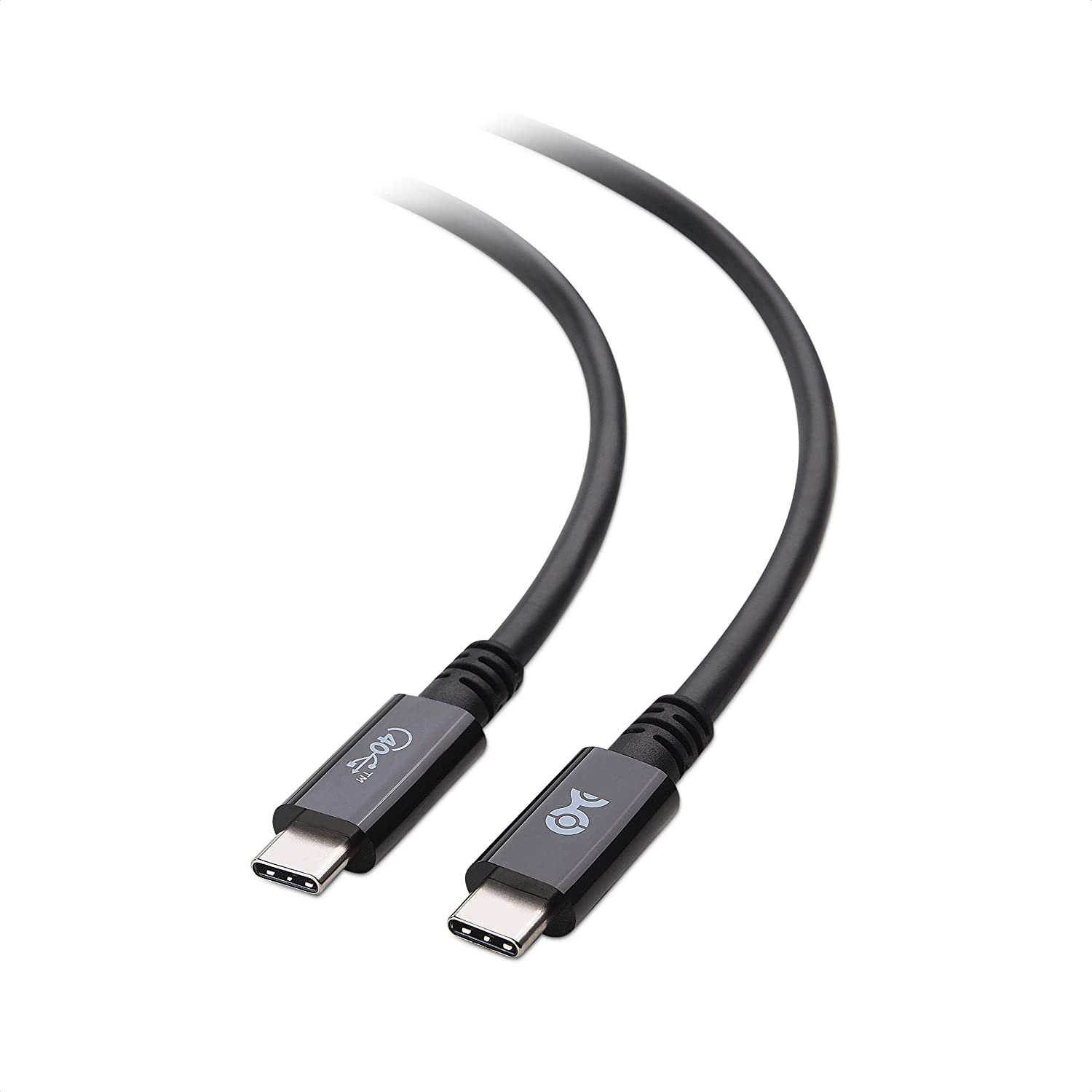
Cable Matters USB3 Cable is but 2.6-foot so it lacks the appeal of long cables. What appealed to us enough to buy the cable is its USB4 rating which promises high-performance.
And no surprise, the cable was able to charge our laptop at 100 watts, and offered the best voltage and lowest resistance thanks to the wires Cable Matters uses and its 2.6-foot length. That also translated into excellent USB 3.1 data transfer rates, monitor support and the only cable here capable of driving our Thunderbolt 3 SSD at a full 40Gbps data rates.
If you’re looking for high-performance in all things and don’t mind the length, the Cable Matters USB4 cable is our pick.
Its weaknesses are its stiff feel thanks to the higher-quality, thicker wires and construction Cable Matters uses, and its price. Looked at in dollars-per-foot, this $20 cable is about $8 per foot. With the Amazon Basics USB 3.1 USB-C cable below, you’re only paying $3.17 per foot.
That Amazon cable can’t match the Cable Matters USB4 in Thunderbolt performance, but few need it. That makes the cable best suited to niche areas but it’s fast nonetheless with excellent construction.
Amazon Basics 6-foot USB-C USB 3.1 Charging Cable
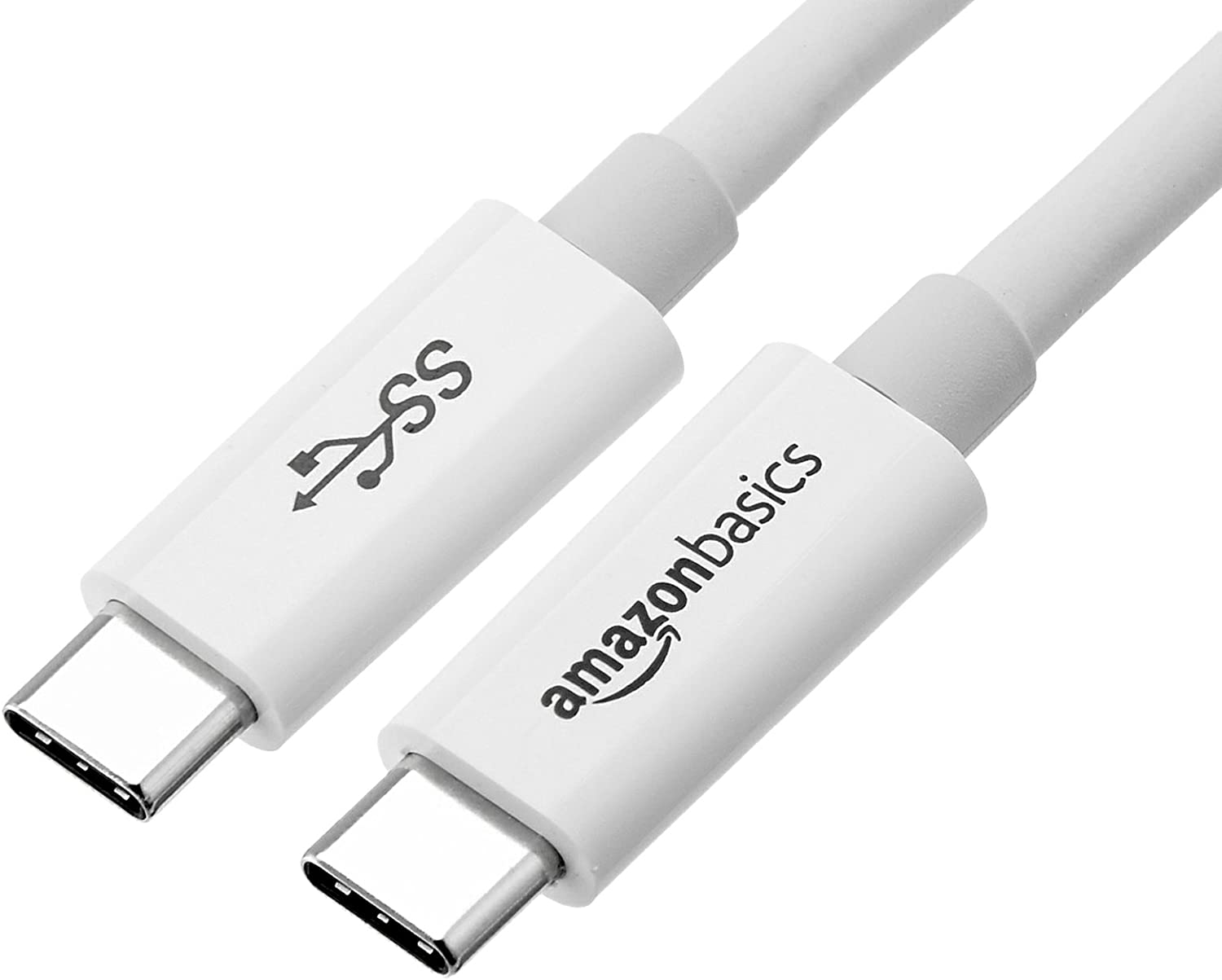
There’s a lot to like about the Amazon Basics USB 3.1 Gen 1 USB-C cable. This 6-foot cable features rubber sleeving and hefty wires that give it a substantive feel without the stiffness you get from some cables.
Its Amazon Basics logo helps prevent you from mixing up this cable with the generic cables you have laying around, and the SuperSpeed logo assures you it’s fast for data transfers.
In our testing, we were able to able to push the limits of our USB 3.2 10Gbps SSD and could also drive our 240Hz 1080p panel. It also was capable of driving our high-performance Thunderbolt 3 drive at its 20Gbps data rate but not at its 40Gbps data rate—which is expected of a 6-foot cable. And despite its USB 5Gbps rating, we could hit 10Gbps speeds anyway which says the cable’s signal integrity is good despite its length. Why not label it USB 10Gbps? Amazon is sticking to the rules which say a 10Gbps isn’t supposed to work on a 6 foot cable.
Also oddly, Amazon specifically claims there’s “no alt-mode” support for this cable so driving a monitor won’t work. Except it does just fine since the alt-mode on USB-C just uses the wires included for the higher-speed USB 3.1 data transfers to run the monitor. We could even drive our high-performance Thunderbolt drive at 20Gbps transfer rates so way to sell yourself short Amazon.
The only real disappointment with the cable is charging is limited to 3 amps which means it tops out at 60-watt charge rates. That’s fine for a Dell XPS 13 or MacBook Pro 13, but not enough for a Dell XPS 15 or MacBook Pro 16. In fact, that’s the primary reason we didn’t give the cable the nod for best brand-name cable pick.
It does carry Amazon’s name which has value to some, but at $19, it’s hardly a steal. With that said, this is a fine cable, but there are indeed ones with more capability too.
Compared to our picks above, we wouldn’t advise purchasing any of the other USB-C cables we tested. Why settle for something inferior? But we understand some will want to see which cables didn’t make the cut and why.
USB-C cables that didn’t make the cut
Dockcase 8.5-inch USB-C cable

The Dockcase USB-C to USB-C cable is the worst value here if you only judge a cable by length and price. In capability though, this 8.5-inch cable is one of the better performers—a consequence of its short length. The shorter the cable, the less the resistance and, well, the better the performance, even with thin wires.
The Dockcase advertises a 100-watt charge rate, 4K video support, and even Thunderbolt 3 support. The company doesn’t mention it but that Thunderbolt 3 speed is limited to 20Gbps, not the full 40Gbps Thunderbolt 3 users expect, so take note. It’s not practical, but we did charge our laptop at 100 watts with the Dockcase.
Physically, the cable is a flat design with a rubbery outer sheath. The strain relief where the cable connects to the housing is minimal, as well, which makes us question its durability over time.
Its length is best suited for an ultra-fast portable USB-C SSD, and can pinch hit for charging or running your monitor. We personally wouldn’t recommend it for use with a high-speed Thunderbolt drive or device though, given its aforementioned limitations with that spec.
Amazon Basics 6-foot USB-C USB 2.0 cable

The Amazon Basics USB-C to USB-C USB 2.0 is the cable that epitomizes minimum effort. At 6-feet long, it will do its job to charge your phone or tablet, and even your laptop at up to 60 watts, and that’s about it. Since it’s a USB 2.0 cable, data transfers to or from your computer will be dog slow compared to a USB 3.1 cable. Moving a 1GB file might take a few seconds on a USB 3.1 cable and nearly a minute with the Amazon Basics USB-C Charging cable.
The cable itself is amazingly light. In fact, it’s probably too light, which means Amazon didn’t really use the thickest wires it could for this cable. That shows up with some of the highest resistance among the cables 6 feet or longer in this roundup, meaning less power delivered to your phone or tablet. Granted, we are talking about 2 percent lower wattage compared to the best of the longer cables here. But still, that’s like a school report card that says “present” as its main selling point.
It’s not all bad for the Amazon Basics cable. It does carry a big-name brand. And its lack of wires to support higher-speed USB 3.1 makes it relatively thin and light, and very pliable.
Would we use this cable to charge our laptop every day? Probably not, but for someone charging a phone or tablet, its lightweight feel can be be a plus.
Anker 6-foot Powerline USB-C cable

This is Anker’s oldest Powerline cable but it’s still available alongside the Powerline II and Powerline III models. As its name tells you: This version is a USB 2.0 (480Mbps) cable, so transferring large files to your phone or tablet from your computer will be tedious at best.
It has a black plastic sleeve without the tacky rubbery feel some cables have. On the inside it’s about average, with actual charging performance somewhat better than the Amazon Basics USB 2.0 cable but not in the class of the Javex cable, which supports charge rates up to 100 watts instead of the Powerline’s 60 watts. Phones, tablets, and light-duty laptops are its best use cases.
Unfortunately, while it’s a decent cable for certain uses, its pricing hurts it. At its typical pricing of $12 it’s not worth it. We’ve seen it more recently for $8, which makes it slightly more attractive, but even at that price, we’d recommend you buy the Javex instead.
JSAUX USB C to USB C Cable 60W 2-pack
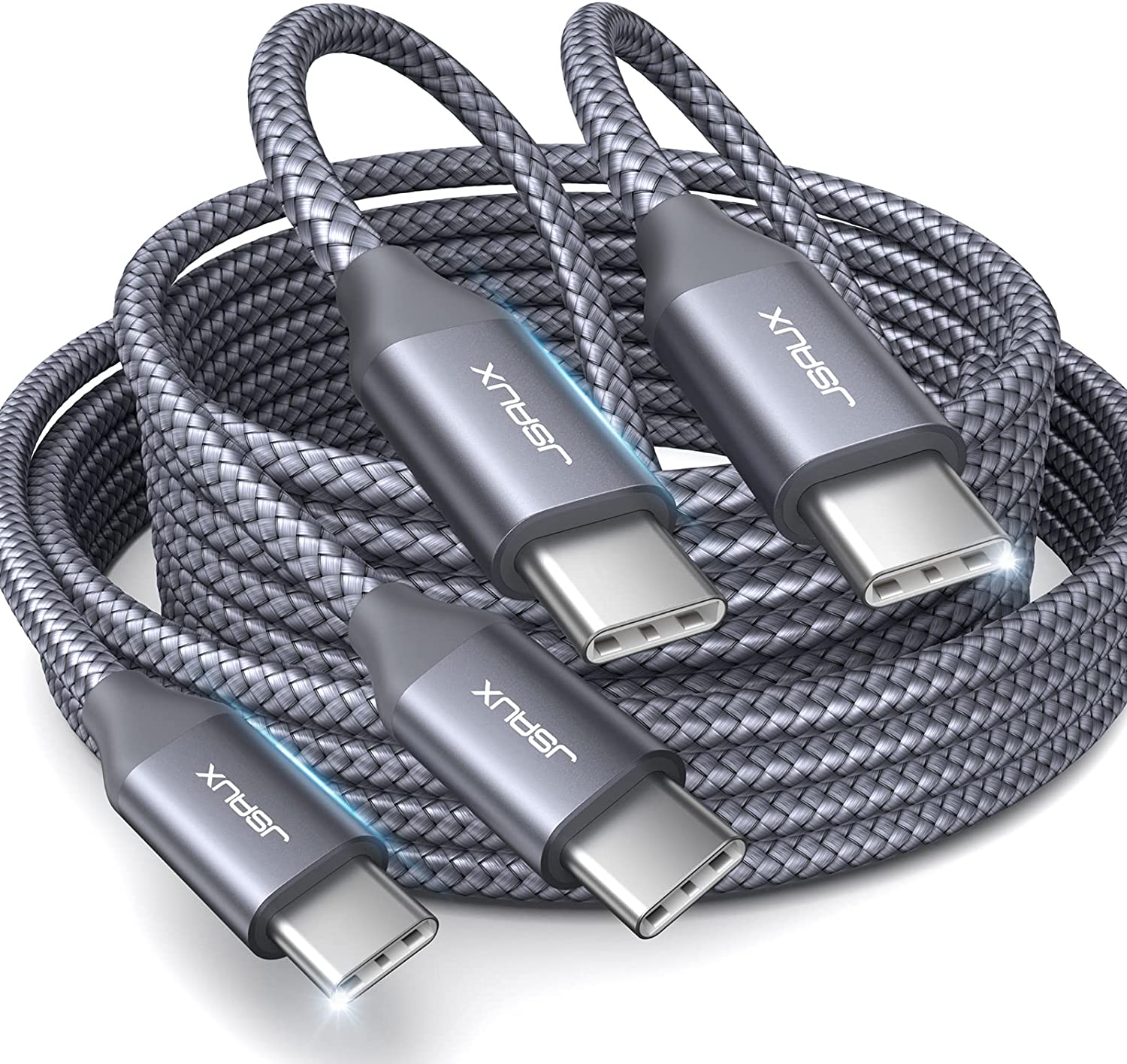
Do you get what you pay for? JSAUX “USB C to USB C Cable” kinda proves the old adage that says if the price is low, there’s a reason for it. Not only do you get a 6.6-foot / 2-meter USB-C to USB-C cable in the box—you get two of them for what other brands might charge you for just one cable. Unlike some lesser-known cables on Amazon, the JSAUX cables are at least properly marketed with warnings that it is NOT a Thunderbolt 3 cable, it can NOT output video, and its charge rate is limited to 60 watts, with data limited to a very slow 480MBps. It’s essentially a basic USB-C charging cable and not the greatest one. We looked at the internal resistance of the cable itself and found it to be pretty mediocre. In fact, we haven’t seen a USB-C to USB-C cable with worse resistance. That pretty much means it skimps on internal wiring and potentially may not hold up over time as the cable is flexed over and over again. With all this said, most people don’t actually need high charge rates on a charging cable (where less resistance would be more valuable) and we think that’s reflected in the more than 31,000 reviews of this top-selling cable—with most of them positive—from around the world.
We’d pass for a slightly pricier cable, and would even prefer the Amazon Basics cable to it, but we do recognize that for charging a smart phone and tablet, it’ll probably be fine, which explains how there are 31,000 happy customers. There are, however, better choices out there for those willing to pay for it.
How we test USB-C cables
For this roundup, we purchased retail USB-C cables for our testing. We physically measured and weighed each cable and examined each connector. A proper USB-C cable should use a one-piece shell rather than a folded shell with a visible seam in it. None of the cables we purchased used the lower-strength folded shells.
We do want to point out that weight does tend to matter. All cables are essentially tiny metallic wire strands bound together with insulation. Sure, the connector, housing, braiding, and outer shell all factors in its weight, but lighter-duty cables literally have fewer wires and are far lighter. For example, the Cable Matters high-performance USB 4 cable is 32-inches long and weighs more than the Amazon Basics low-performance USB 2.0 cable, which is more than twice as long.
That’s not always better though, as a cable with more wires that are a heavier gauge—or thicker—are less pliable and also take up more space in your bag.
EXPLORE FREQUENTLY ASKED QUESTIONS
- Which USB-C cable provides the fastest charging speed?
- What are the key factors to consider when buying a USB-C cable?
- How do the performance differences among USB-C cables affect data transfer?
- Which USB-C cables are recommended for both charging and fast data transfer?
- How can I ensure I’m buying a high-quality USB-C cable without overspending?
Are they all wired correctly?
You’d think you could tell whether a cable is USB-C 2.0 cable by looking at the wires in the connector but that’s not the case. Some cables use connectors with pins that aren’t hooked up to anything.
To check each cable, we use a BitTradeOne USB Cable Checker 2.0 to first see what actual wires are inside of the cable and whether they are hooked up correctly and what they do. For example, a USB-C cable that is fine for charging but a dog in data transfer will show up as being wired only for USB-C 2.0, as you can see below by the green LEDs. The “CC” LED indicates the Cable Configuration channel is wired up correctly.
A full-featured USB-C cable has additional wires to carry higher-speed data and the USB Cable Checker 2.0 shows this Cable Matters USB 4 cable in the picture below with the correct wiring all available. The small LED display also tells us that the cable has an ID e-Marker chip, the shell is properly grounded to the cable, and it does a quick resistance test too. The cable tester also checks to see if the metal shell of the cable is grounded to the ground wire of the cable, which is required by spec. Every cable here was properly grounded.
Resistance is futile
The resistance check from our cable checker is quick and dirty, so we augmented that by also measuring the resistance of the cable’s ground wire and vbus wire using a milli-ohm meter connected via a pair of USB-C breakout boards. The breakout boards at both ends add about 30 mohms to the total. By spec, a USB-C cable should not exceed 83 mohms on the ground wires and 167 mohms on the voltage bus.
Many of the cables we tested were within spec or close enough that it didn’t matter, since there’s likely even more resistance we’re not able to account for with our method. We definitely could tell which cables used heavier-gauge or thick wires with less resistance to restrict the flow of electricity, and which ones cheaped out.
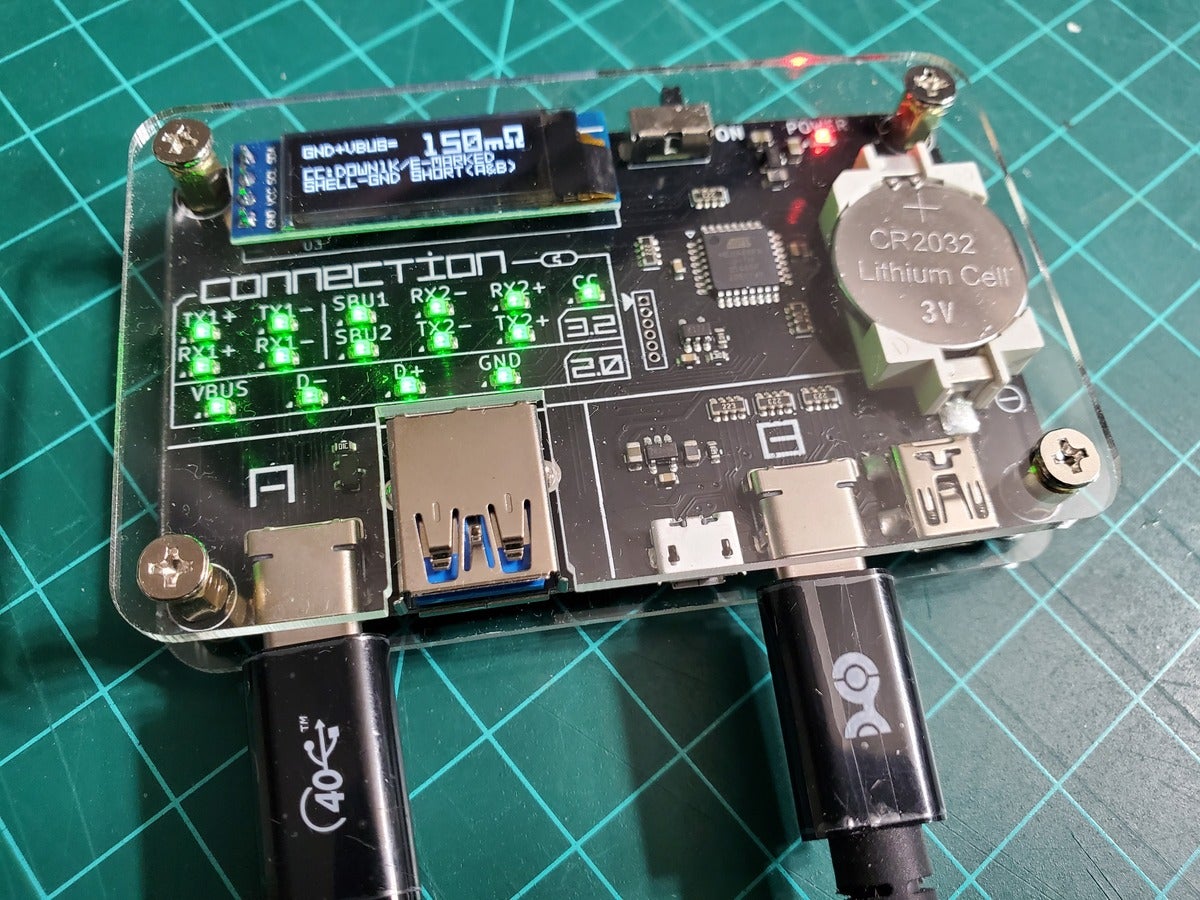
What did the e-Marker say?
Since each of the more advanced cables carries an e-Marker that tells the computer what the cable can do, we noted that and the validity of the e-Marker’s claims. All but one of the cables met those claims, but the one that was wrong was way, way wrong. It claimed USB 3.2 10Gbps transfer speeds and a 1-meter length, when it literally didn’t have the wires for the faster transfer speeds and was actually 2 meters long.
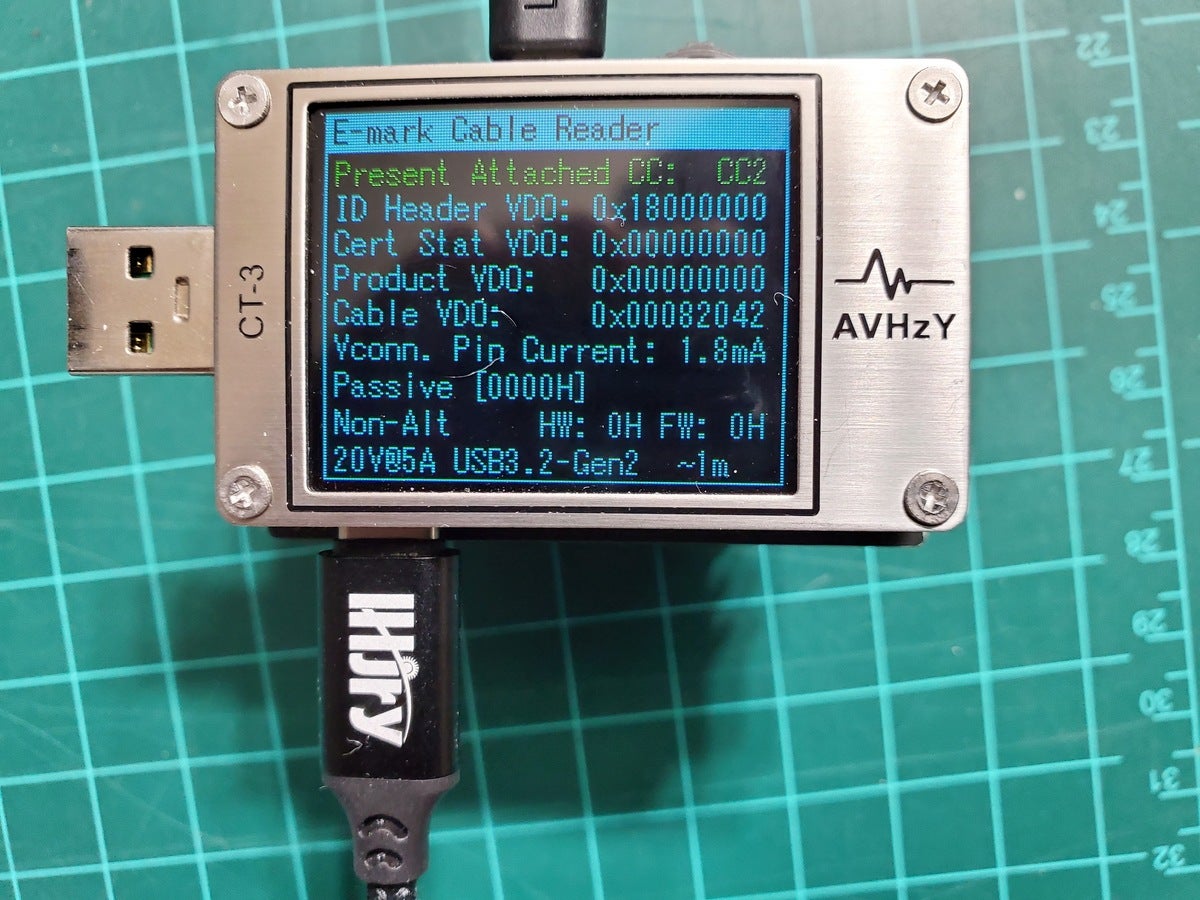
We then looked at how fast the cable would charge and transfer data, and whether it supported an alternate mode to run a monitor, using real-world hardware.
For charging speeds we recorded the maximum wattage at which the cable could charge an Asus ROG Strix 15 gaming laptop over its USB-C port using USB-Power Delivery with an Aukey 100 watt USB-PD charger as the source while the laptop was under load. USB-PD today is limited to 100 watts (with a 240-watt spec on the way). Any USB-C to USB-C cable should handle 3 amps at 20 volts, or 60 watts. All of the USB-C to USB-C cables fell into the standard 60-watt or 100-watt camps.
We didn’t test the temperature of each cable’s housing, but we did test the cheapest cable by running it at 5 amps and 20 volts for an hour. The housing heated up by 50 degrees Fahrenheit, and the cable itself became relatively warm (see the thermal image below). Not ideal, but it did this without failure. We subjected other cables to two-hour loads without failure, as well.
For one final charge test, we tasked each cable with a 20 volt, 3 amp and 20 volt 5 amp load (for the 5-amp rated cables) and measured the voltage delivered at the end of the cable using our CT-3 meter.
The cables with the thinnest-gauge wires add more resistance, which in turn reduces the voltage delivered to your laptop, tablet, or phone.

For data transfer, we measured the speed using Crystal Disk Mark 8 while plugged into the USB-C/Thunderbolt 4 port of an MSI Prestige 14 Evo laptop. Since the cables can also be used to transfer data from a Thunderbolt storage drive, we measured how fast that happened using a high-speed SSD-based SanDisk Professional Thunderbolt G-Drive. We found three transfer modes among the cables tested: Thunderbolt 20Gbps performance, Thunderbolt 40Gbps performance, or zero performance because the cable would not work at all with a Thunderbolt drive.
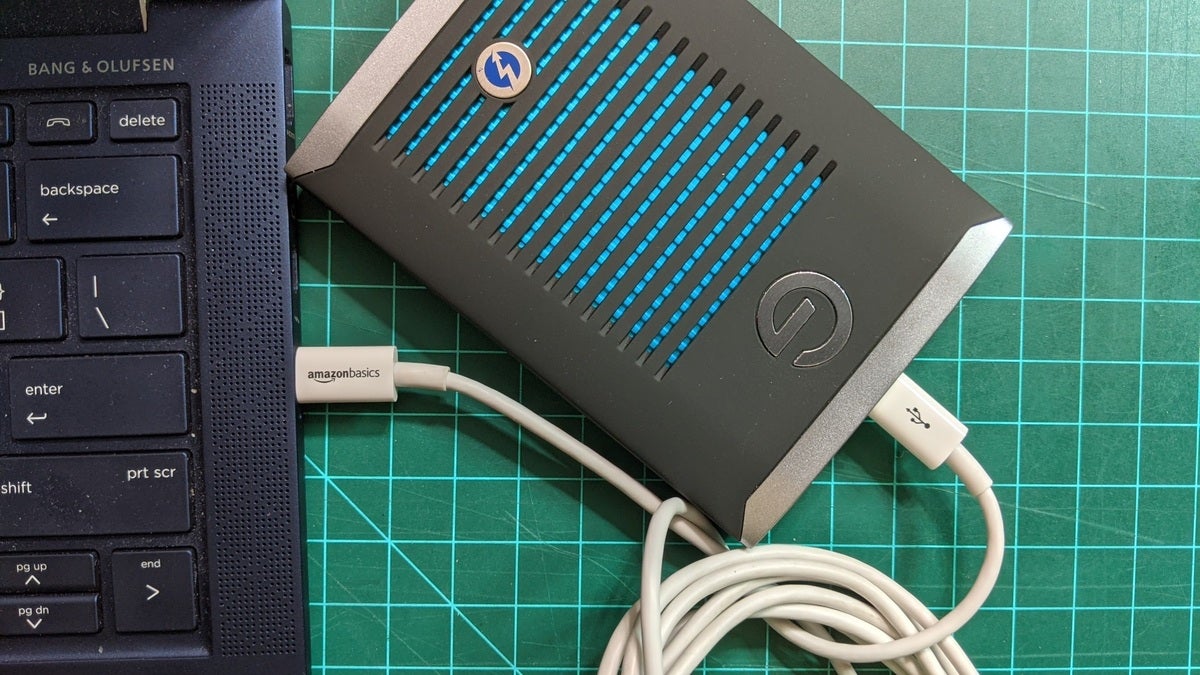
Our last test looked at each cable’s capability running an Asus ROG Strix 17.3-inch portable gaming monitor. The monitor is a high-performance gaming monitor with a resolution of 1920×1080 and refresh rate of 240Hz—which is basically the same bandwidth requirements of a standard 4K 60Hz display.
FAQ
What are the different types of USB-C to USB-C cables?
There are a number of different types of USB-C to USB-C cables including: USB 2.0, USB 3.1 Gen 1, USB 3.1 Gen 2, and Thunderbolt 4.
The main difference between all of these is their data transfer rates and their charge rates. Basic charge cables give you very slow data transfer speeds and typically only up to 60 watts. For a phone, tablet, and even most small laptops such as a Dell XPS 13 or MacBook Pro 13 that’s fine. As you move up to larger laptops such as a Dell XPS 15 or MacBook Pro 16, 60 watts will limit how fast you can charge.
The other key differentiator is speed. USB 2.0 is a plodding 480Mbps. USB 3 cables range from 5Gbps to 20Gbps. While USB4, and Thunderbolt 3 and Thunderbolt 4 can support up to 40Gbps of throughput.
Thunderbolt, USB4, and many USB 3 cables also support display support using DisplayPort.
What are USB-C cables used for?
USB-C cables today are used for transferring data, running monitors, and charging everything on the planet from $5 LED trinkets to $2,000 laptops and even power tools now. It is basically the most common type of cable for electronics today and thanks to its universal and open design it has rapidly replaced all other competitors including Apple’s Lightning as well as older USB cables. It’s appeal is the reversible nature so you no longer have to look for alignment. With its ability to handle 240 watts now, USB-C to USB-C cables will likely begin replacing other proprietary cables as well.
What is the difference between a Type A and Type C cable?
There are a few key differences between the two. A USB-C to USB-A cable has a rectangular connector on side with 4- to 9-pins in it. As you know from trying to plug a mouse into your PC, it only fits in one way and you usually never get it right the first time. On the other end of a USB-C to USB-A cable, you will find the modern oval USB-C connector, which fits in both ways and packs far more pins and wires inside. The short story is that a Type A to Type C cable will typically charge at much slower speeds than a Type C to Type C cable as well as transfer data at far lower data rates. That isn’t always the case as some phones that use special Type A to Type C chargers and cables will indeed charge very fast—but they’re usually proprietary. With most new phone chargers going to USB Type C, you’re probably going to usually want a Type C to Type C cable.

